In the beautiful state of Washington, nice weather brings an unwanted assortment of buzzing and biting insects. From relentless mosquitoes to persistent ticks, these tiny creatures are not only a nuisance but can also pose significant health risks. They emerge in large numbers, ready to feast, making spending time outdoors less enjoyable.
This article will familiarize you with some of the most annoying insects in Washington, their behaviors, and bites. Read on to understand these insects better and to learn how to coexist without the bites and the buzzes of Washington insects!
1. Yellowjackets
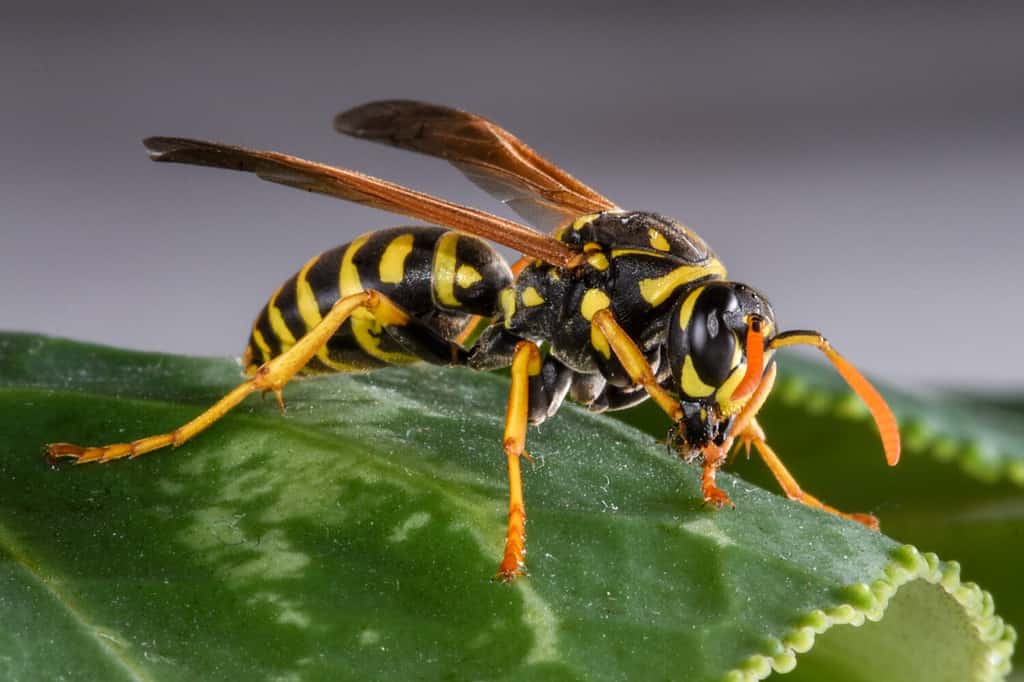
Yellowjackets are nasty and annoying insects that sting and bite!
©Randy Runtsch/Shutterstock.com
One of the most frequently encountered types of wasps in Washington is the yellowjacket. These insects are similar in size to bees and are easily identified by their black bodies marked with distinct yellow patterns on their heads and ringed stripes on their abdomens. Their faces are predominantly yellow, and they have dark eyes. Their large antennae are noticeable, and their wings are usually folded lengthwise at rest.
You can find yellowjackets wherever human habitation exists. They are known to construct their colonies in a variety of locations, including underground, within hollow logs, attics, tree stumps, under eaves, wall cavities, and even inside recycling bins.
In terms of diet, adult yellowjackets opt for food sources rich in sugars and carbohydrates, such as plant nectar and fruits.
Why Are Yellowjackets Annoying?
Notorious for their aggression towards humans, yellowjackets also threaten sizeable honeybee colonies, which they target for food, consuming both the bees and their larvae. Additionally, their presence can be more than just irritating, as their stings are quite potent and painful.
The aggressive nature of yellowjackets extends to both biting and stinging. They often bite to secure a firmer grip before driving their stinger in. As they retain their stinger after an attack, they can inflict multiple stings and often do so even without being provoked. These assertive creatures fiercely defend their colonies.
2. Mosquitoes
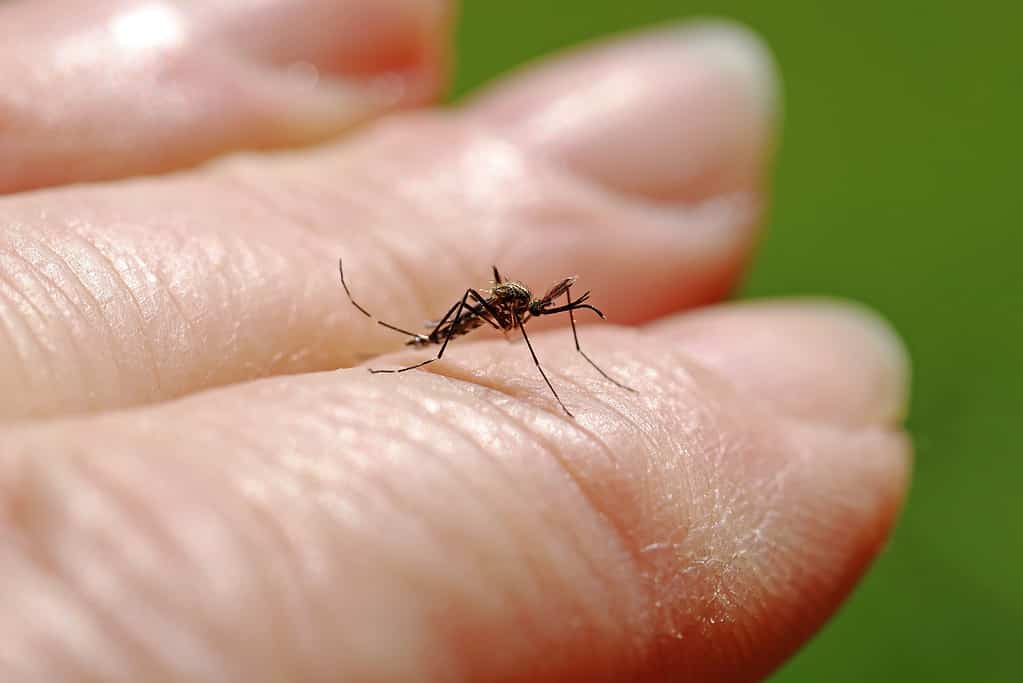
One of the most common biting insects in Washington is the mosquito.
©Astrid860/ via Getty Images
In Washington, over 40 distinct species of mosquitoes have been identified, many of which are carriers of diseases. The two most frequently seen species are the northern house mosquito and the western encephalitis mosquito.
Adult mosquitoes typically measure between a quarter and three-eighths of an inch in length, possessing a slim, oval-shaped body. They are generally gray in color but can also exhibit green, silver, white, or even iridescent blue scales. White stripes often adorn their abdomens.
The preferred habitats of mosquitoes can vary. Some favor human environments, while others are drawn to woods, marshlands, or tall grasses. One constant among all species is their need for water, where their larvae and pupae reside, particularly stagnant water.
Plant nectar, such as that from flowers and fruits, along with plant sap, honeydew, and other plant-based fluids, are also dietary staples for mosquitoes.
Why Are Mosquitoes Annoying?
Mosquitoes are notorious pests known for their biting behavior. Their bites can disturb outdoor activities such as pool days or park walks. Beyond their nuisance, their capacity to transmit diseases makes them a significant concern for humans.
Mosquitoes seek blood as a source of nourishment for their reproductive processes. The proteins, iron, and amino acids found in blood allow female mosquitoes to develop their eggs. Males, on the other hand, do not bite. Interestingly, mosquitoes have been observed feeding on various hosts, including other insects, mammals, and even fellow mosquitoes.
3. Bald-Faced Hornets

Bald-faced hornets can deliver multiple painful stings and bites when they feel threatened.
©Ernie Cooper/Shutterstock.com
Another frequent annoying insect in Washington is the bald-faced hornet. Despite their name, these large stinging creatures aren’t actually hornets. They’re closer relatives to yellow jackets, featuring elongated, slender bodies characteristic of wasps. They are predominantly black, with a distinct off-white pattern marking their faces.
These hornets make their homes in wooded and urban areas. They’re known for building their nests in trees, shrubs, overhanging rocks, and residential eaves.
Their diet consists primarily of soft-bodied insects like caterpillars and aphids. Though they also forage for nectar, which provides carbohydrates, and pollen for protein from flowering plants.
Why Are Bald-Faced Hornets Annoying?
Bald-faced hornets exhibit a high degree of protectiveness towards their nests and won’t hesitate to deliver multiple painful stings if they perceive a threat. These stings can be excruciating, and in cases where the individual is allergic to the venom, the reactions can be severe, even life-threatening.
An unprovoked attack by one of these hornets usually indicates the presence of a nest within a three-foot radius.
4. Bed Bugs
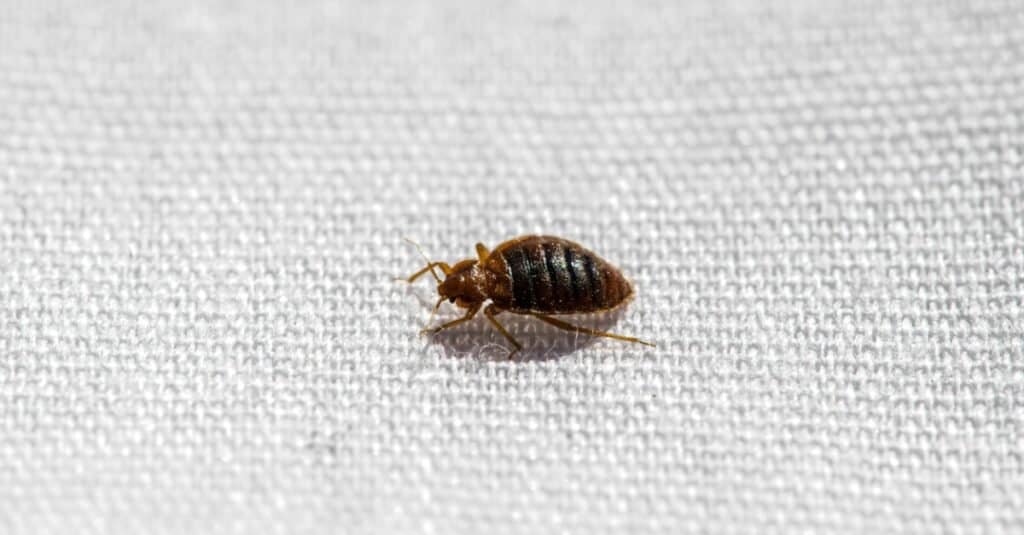
These tiny annoying insects will bite you in your sleep!
©iStock.com/Mainely Photos
Bed bugs are tiny insects that are a growing concern across Washington, frequently spotted in homes, apartments, rental properties, and even hotels. The most prevalent bed bug species is Cimex lectularius.
Adult bed bugs display a reddish-brown color and have elongated bodies that resemble the size and form of an apple seed. Depending on their feeding schedule, they can appear flat or balloon-like.
Common hiding spots for these pests include mattress seams, crevices in bed frames, the interiors of mattress coils, dressers, bedside furnishings, wooden paneling, under peeling wallpaper, wallboards, frames of doors and windows, and in any room adjacent to where hosts sleep.
Bed bugs exclusively feed on blood. The typical bed bug (Cimex lectularius) shows a preference for humans but won’t hesitate to feast on other warm-blooded creatures, including birds, cats, dogs, and rodents.
Why Are Bed Bugs Annoying?
It is pretty easy to see how these pests can be annoying. While bed bugs don’t transmit diseases, their presence can lead to itchiness and sleep disturbances, making them unwelcome guests in any home. The potential for disruption and damage they bring makes them one of the most annoying household pests.
Clusters of bed bug bites can result in raised, red bumps, particularly on exposed skin areas such as hands, legs, and neck. These bites not only cause discomfort due to itching but they can also lead to potential skin infections
5. European Fire Ant
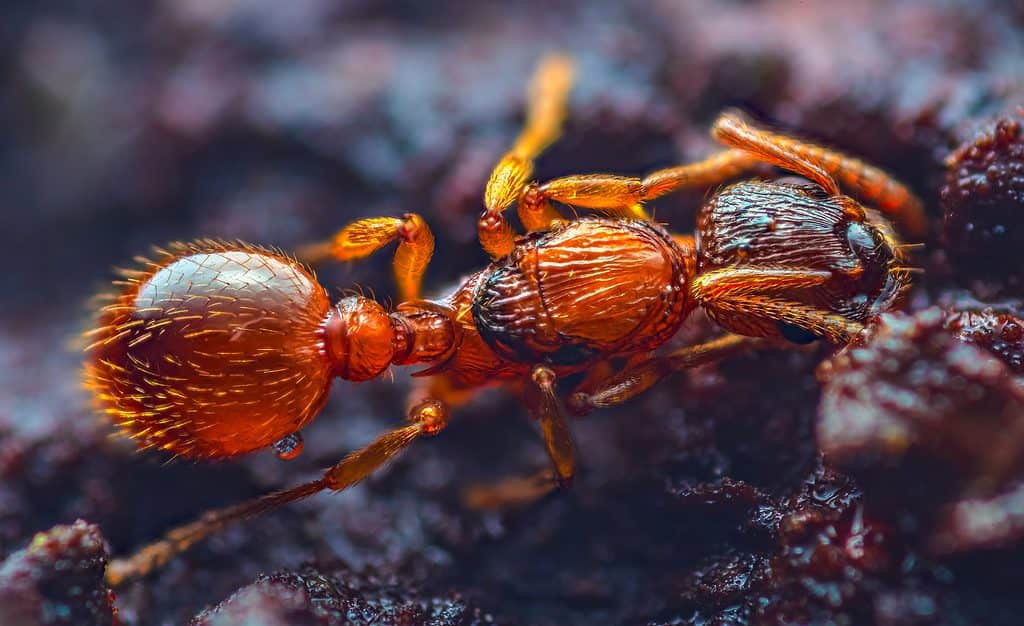
This tiny insect can administer a very painful sting that, for some people, can cause an allergic reaction.
©Lukas Jonaitis/Shutterstock.com
The European fire ant, native to Europe and Asia, has now spread its wings and made its presence known in Washington State.
While they might resemble typical house or garden ants, European fire ants are easily identifiable by their copper-brown color and dark abdomen.
Their preferred habitats range from decaying logs or soil to beneath rocks and human-made debris. They can even be found nestled in dense grass clumps or leaf piles. The colonies they build vary in population, housing a few hundred to hundreds of thousands of worker ants. Additionally, these nests often host multiple egg-laying queens.
Feasting on both living and decaying plant and animal matter, these ants are known to forage and return food to their colonies for consumption.
Why Are European Fire Ants Annoying?
These stinging ants pose a potential health and ecological risk to the U.S. They’ve become a significant nuisance in the U.S., mainly due to their aggressive nature and stinging behavior, which disrupt outdoor activities in gardens and parks.
Owing to their high densities, seen foraging across plants, shrubs, and trees, and the concealed nature of their nests, there’s a high chance of humans and pets unintentionally disturbing European fire ant colonies. This disruption often results in many ants delivering a painful sting.
In some rare instances, the venom from these stings has even caused severe allergic reactions, including life-threatening anaphylactic shock.
6. Asian Lady Beetle
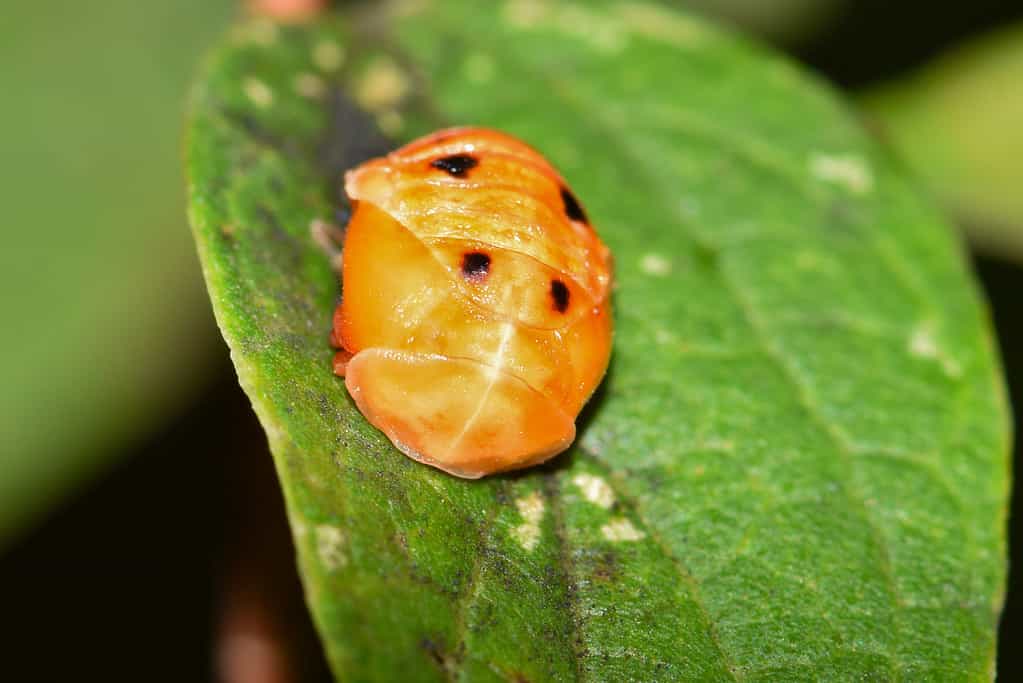
This insect may swarm your home in October when looking for shelter for the winter.
©Brett Hondow/Shutterstock.com
The Asian lady beetle, often referred to as the “Halloween Beetle,” made its way into Washington and quickly spread throughout the state. Its arrival in homes often coincides with October, as it seeks warm shelters to hibernate through winter.
These beetles, approximately 1/4″ in size, are equipped with wings and have the ability to fly. While the most commonly seen lady beetles are recognized by their red bodies adorned with black spots, they can also be found in many colors, including yellow, tan, and orange, with or without black markings.
Across the U.S., these beetles dwell in ornamental and agricultural crops, with roses, alfalfa, soybeans, corn, and tobacco among their preferred habitats.
Predominantly feeding on aphids and other soft-bodied insects that pose a threat to crops, gardens, and landscapes, the multicolored Asian lady beetle and other lady beetle species contribute positively to pest control.
Why Are Asian Lady Beetles Annoying?
The Asian lady beetle actually has several beneficial properties, as it consumes crop-destroying insects. But, their benefits come with a downside. Known for the irritating habit of congregating on building sides and entering homes in the fall, these beetles can become a significant household annoyance during the late fall and winter months.
In addition to the nuisance they cause, Asian lady beetles may bite humans, leading to allergic reactions in some individuals. Although these insects are usually docile and only bite when in search of food or moisture, reactions can include asthma, an itchy nose and eyes, and swelling.
7. Biting Flies
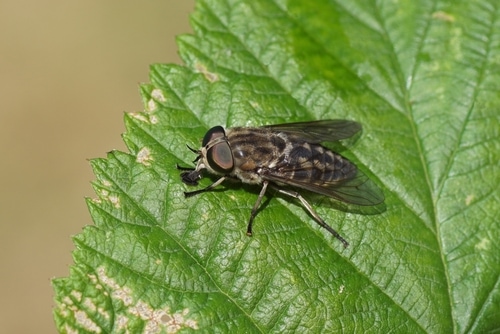
This type of fly is known for attacking horses but will also make humans their victim as well.
©Thijs de Graaf/Shutterstock.com
Biting flies are a common sight to those living in Washington. Notably, deer and horseflies are infamous for their persistent buzzing, stealthy landings on bare skin, and their stingingly painful bites.
Homeowners may encounter a diverse range of biting flies, from sizable horse flies to almost invisible midges. Unlike most flying insects with four wings, flies are unique, with just two. Their mouths are specifically structured for piercing and slurping up liquids.
These adult flies are often found near trails adjacent to lakes, streams, swamps, marshes, and even inside homes during the summer season!
Adult flies, and their larvae primarily consume decaying organic matter, such as vegetables, meat, fruits, and animal & plant secretions, including human waste. Additionally, both genders of flies are nectar feeders.
Why Are Biting Flies Annoying?
The presence of biting flies can be extremely irritating due to their behavior: hovering around you, attempting to land on you, nearly flying into your mouth while you speak, and even trying to consume your food when it’s left unattended. Eliminating them can be a challenging task.
Furthermore, these flies pose a health risk as they can transmit tularemia, a bacterial disease they acquire from wild animals. Their bites may also trigger serious allergic reactions in some individuals.
8. Green Lacewings

It is not common to be bitten by green lacewings, but they may give a painful bite when threatened.
©iStock.com/Pavel Abramov
Green lacewings are a prevalent insect in Washington, known for their role as common predators within the ecosystem.
Adult green lacewings have a length of around 3/4 inch, a light green hue, and display a delicate aesthetic thanks to their lacy wings. One peculiar feature is their eyes which resemble two golden orbs. These insects are not particularly strong fliers and are often found in proximity to aphid colonies.
Habitually, lacewings inhabit grassy clearings, roadside areas overrun with weeds, shrubs, and other vegetation.
While the adult green lacewings primarily consume honeydew, a sugary secretion produced by aphids, and the nectar and pollen from flowers, some also prey on and consume insects with soft bodies, such as aphids.
Why Are Green Lacewings Annoying?
Although brown and green lacewings, including their larvae, can bite humans, they usually do so only when disturbed or sensing a threat. While the bites are not toxic, an infestation of these insects can lead to multiple bites, causing annoyance for gardeners.
9. Earwig
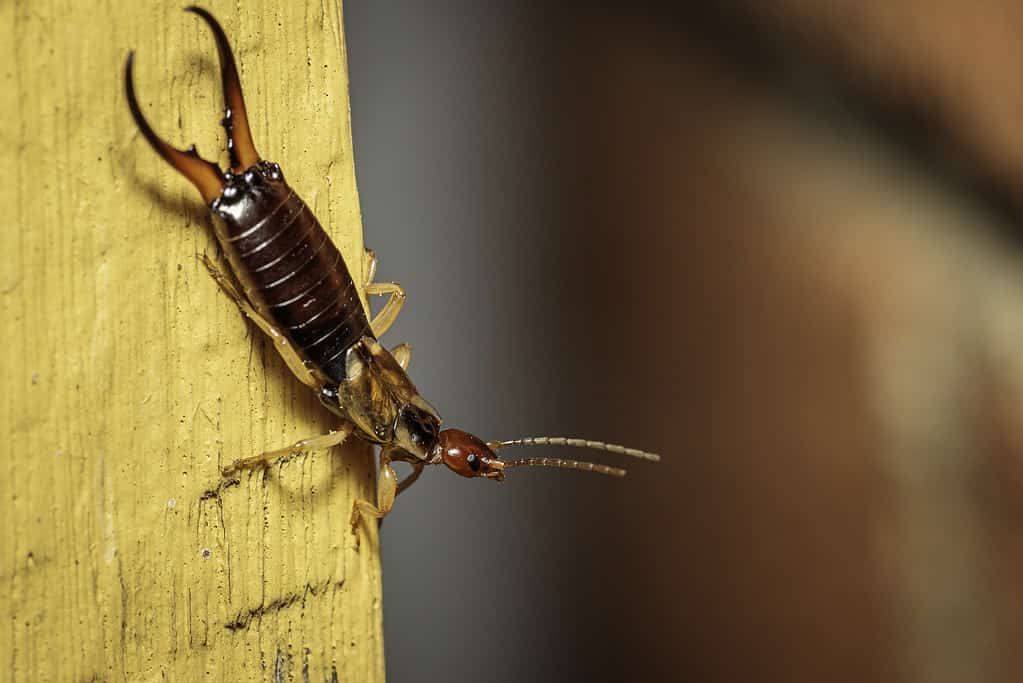
Though earwigs look extremely threatening, they do not commonly bite humans.
©iStock.com/Jonathan Steinbeck
Earwigs commonly infest homes, garages, and other buildings within Washington.
Slightly exceeding an inch in length, these insects boast slender antennae and a lengthy rear pincher. Their bodies exhibit a dark brown hue, with wing covers and lighter brown legs. These insects have compound eyes, adding to their distinct look.
Typically, earwigs prefer dwelling underground, beneath rocks, or within decaying wood. At times, they find their way into homes, either via plants or through cracks in the building’s foundation.
As scavengers, earwigs feast on deteriorating plant matter. They can also consume weak or deceased insects and other small organisms. On occasion, they might feed on healthy plant material as well.
Why Are Earwigs Annoying?
Generally, earwigs are more of a nuisance than a threat. Their presence can be annoying, primarily due to their unsettling appearance. Earwigs aren’t venomous and only use their pincers defensively if handled.
An earwig infestation can become quite annoying and, in extreme cases, potentially harmful. This is mainly because earwigs can proliferate swiftly, causing damage to structures and piles of straw or debris.
10. No-See-Ums

Also called midges, no-see-ums are extremely annoying insects that can be found in Washington.
©Jamierpc/Shutterstock.com
Throughout the warmer months, and even during winter, the people of Washington remain susceptible to the annoying bites of no-see-ums.
These tiny insects are structured with three body parts: the head, thorax, and abdomen, equipped with six legs and wings. Their color ranges from black and brown to grey, with some displaying stripes.
Typically, no-see-ums inhabit areas with standing or sluggish waters, such as ponds, marshes, lakes, and streams. Certain species can even adapt to saline or brackish environments where freshwater intersects with saltwater.
Adult no-see-ums draw nourishment from flower nectar, but female no-see-ums also require blood from insects, reptiles, or mammals to breed.
Why Are No-See-Ums Annoying?
No-see-ums are more than just pesky insects; they can bite, injecting saliva that may induce irritation, pain, itching, and red bumps. While for some, these bites are a minor inconvenience, for others, they may result in persistent painful lesions.
Despite the tiny quantity of blood no-see-ums extract, numerous people experience allergic reactions to the anticoagulant these insects introduce into their victims, which is to prevent the blood from clotting.
Summary of Annoying Insects in Washington
| Insect | Bite Symptom |
|---|---|
| Yellowjackets | Swelling, pain, itching, nausea, and fatigue |
| Mosquitoes | Reddish & puffy bump, dark spots, itchiness, and allergic reactions |
| Bald-Faced Hornets | Swelling, redness, itching, pain, and allergic reactions |
| Bed Bugs | Itching, swelling, sores, and allergic reactions |
| European Fire Ant | Itching, burning, and swelling |
| Asian Lady Beetle | Pain, itching, discomfort, and swelling |
| Biting Flies | Swelling, itching, nausea, fever, and headache |
| Green Lacewings | Small itchy red bump and allergic reactions |
| Earwig | Swelling, redness, and bleeding (in rare cases) |
| No-See-Ums | Burning, itching, and red dots on the skin |
The photo featured at the top of this post is © akiyoko/Shutterstock.com
Thank you for reading! Have some feedback for us? Contact the AZ Animals editorial team.






